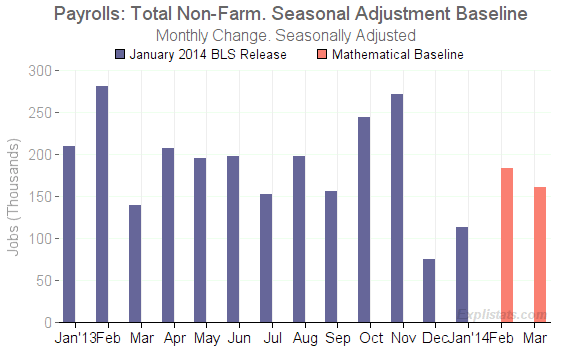The Bureau of Labor Statistics will publish its February Payrolls Survey on Friday, March 7th.
Barring revisions to January and December numbers (which will almost definitely be sizable) the underlying mathematical trend projects an increase of 183,000 jobs in February. This follows the current estimate of a January increase of 113,000. (Total Non-Farm, Seasonally Adjusted).
Mathematical Baseline Numbers – Assuming No Change in Economic Trend
Projected monthly increase in seasonally-adjusted payroll numbers for February.
January’s survey included two outliers which have the potential to disrupt the trend. (See below)
| Sector | Jan. Actual | Feb. Projection |
|---|---|---|
| Total Non-Farm | 113,000 | 183,000 |
| Private | 142,000 | 184,000 |
| Government | -29,000 | -1,000 |
The Seasonal Adjustment Process
Most industries see job levels rise and fall due to the time of year. In order to get a view of any underlying, non-seasonal changes, a mathematical procedure is used to “seasonally adjust” the data, stripping out calendar effects.
The mathematics used by the Bureau of Labor Statistics in seasonally adjusting the raw payroll data is complex. It has a difficult task and does not perform perfectly. There are residual biases in the output numbers and these will tend to persist in future months, although they will change as new data are fed in each month.
We look at these BLS biases with a view to preparing for the February numbers, due out this Friday, March 7th.

Click to enlarge
Applying the biases with no changes in trend
To get a feel for the effect of these biases, we compute what the next few months’ reported growth in payrolls would be, if:
- The underlying momentum of the jobs growth seen in recent months were to continue.
- No major reporting errors caused by employers failing to report their survey data on time
The results for February overall payroll numbers are shown in the table and chart above.
Now, both of the assumptions (1) and (2) are significant, and so our bias-numbers cannot be treated as a forecast, but more of a “baseline”. If the effect of (2) is small, then we can look at how the actual February numbers compare with this baseline and deduce from that something about any change in momentum.
Effect of Possible Revisions and Reversals in January Estimates
Stores selling sporting and books, music and hobby goods saw a very large decline, seasonally adjusted, in January of 22,300 jobs, or 3.6% of the workforce. This cannot be accurate. Either there was some large under-reporting or the usual unadjusted, seasonal decline in January happened earlier than usual in the month.
If the former is the case, then the January drop may be reduced and thus the February gain would come in below trend. if the latter, then the unadjusted February level should be higher than expected, resulting in an above trend February gain.
The Telecommunications sector also saw a significant drop in employment in the January survey: A drop of 10,200 or 1.2% of the workforce. This also seems extreme. There is no great seasonal effect and so this may be some under-reporting. It is unclear, though, what if any effect this might have in February.
It should be noted that no strikes were recorded by the BLS, and no news of mass layoffs in those industries was readily apparent in the news.
Overall, there are 33,000 job losses which might swing the February trend number of 183,000 by, speculatively, +/- 20,000 jobs, but with the bias on the upside.
